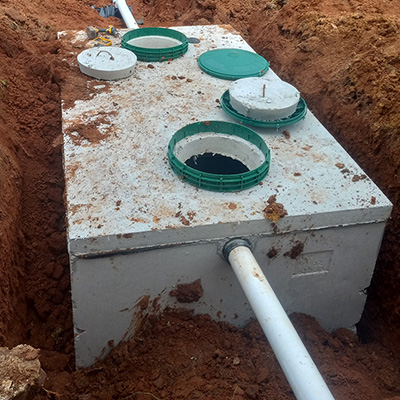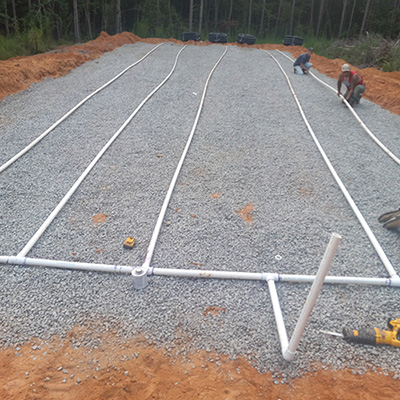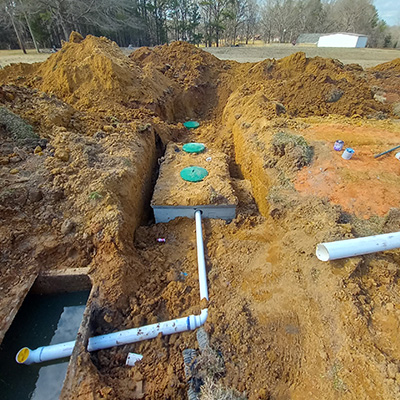Septic Tank Installation In Alabama
Whether it’s new construction or a replacement system,
K and K Septic offers professional installation of many kinds of septic systems at competitive rates.

Invest in Durability: Choose Concrete
Your septic system is a crucial part of your system, it manages wastewater for your entire property. Choosing the right material matters. Here’s why a quality concrete septic tank stands out –
Concrete’s inherent strength and durability are great for longevity. Unlike some alternative materials, a properly constructed concrete tank can last for decades, minimizing the need for costly replacements down the line.
Concrete’s weight provides a stable foundation for your septic tank. This is crucial, especially in areas with fluctuating water tables or heavy soil pressure. A stable tank prevents potential damage or movement that could disrupt your system’s functionality.
Concrete is a naturally watertight material. This minimizes the risk of leaks or contamination of the surrounding soil with untreated wastewater.
Concrete tanks can be built significantly larger than some alternative options. This increased capacity is important for larger households or commercial properties with higher wastewater volumes.
By installing a quality concrete septic tank, you’re buying a long-lasting, reliable solution for your wastewater management needs.
Anaerobic Septic System
Conventional anaerobic septic systems are perfect for many single-family homes. These underground systems rely on a natural two-part process: the septic tank and the drainfield.
The journey begins in a watertight septic tank, where incoming wastewater separates. Solids settle at the bottom, forming sludge, while lighter materials like oils and grease rise to the top, creating a scum layer. Bacteria within the tank naturally break down organic matter in the remaining liquid effluent.
This liquid then exits the tank and travels to a network of perforated pipes buried within a drainfield. The drainfield, lined with gravel and sometimes a special fabric, allows the effluent to slowly disperse into the surrounding soil. Here, natural microbes further purify the wastewater before it filters back into the environment. Because they are a well-understood technology, conventional systems are typically easier and less expensive to repair compared to some newer septic system options.


Chambered System
For homeowners facing challenges with high groundwater tables, chambered septic systems offer a compelling alternative to traditional gravel drainfields. These systems utilize a series of connected chambers instead of gravel for wastewater dispersal.
Imagine open-bottomed chambers nestled within the soil. Wastewater effluent from the septic tank flows into these chambers, where it comes into contact with the surrounding soil. This soil, teeming with natural microbes, acts as a treatment zone, effectively purifying the wastewater before it disperses further into the ground.
Chambered systems are often easier to install compared to conventional systems, and some chambers are even constructed from recycled materials. However, the added chambers may require more frequent maintenance to ensure optimal performance.
Engineered Mound System
For rural properties with shallow soil or high groundwater tables, engineered mound systems provide reliable wastewater treatment. These engineer-designed systems elevate the drainfield above ground level, offsetting the imposed limitations by shallow soil or a high water table.
The main difference with a mound system is the precisely engineered mound constructed with layers of sand and gravel. Wastewater effluent from the septic tank is pumped into a distribution network within this mound. As the effluent trickles through the sand, it undergoes the same natural microbial action that happens in a conventional drainfield.
Due to their engineered nature, mound systems require careful planning and execution. The involvement of a licensed civil engineer is crucial for designing the mound’s size and structure to ensure it functions optimally. Additionally, local and state health departments often have specific regulations regarding mound systems. Obtaining the necessary permits and utilizing a licensed installer like K and K Septic are essential steps for a successful mound system installation. While these systems may require more space and upfront investment, they offer a dependable solution for wastewater management on challenging terrain.

